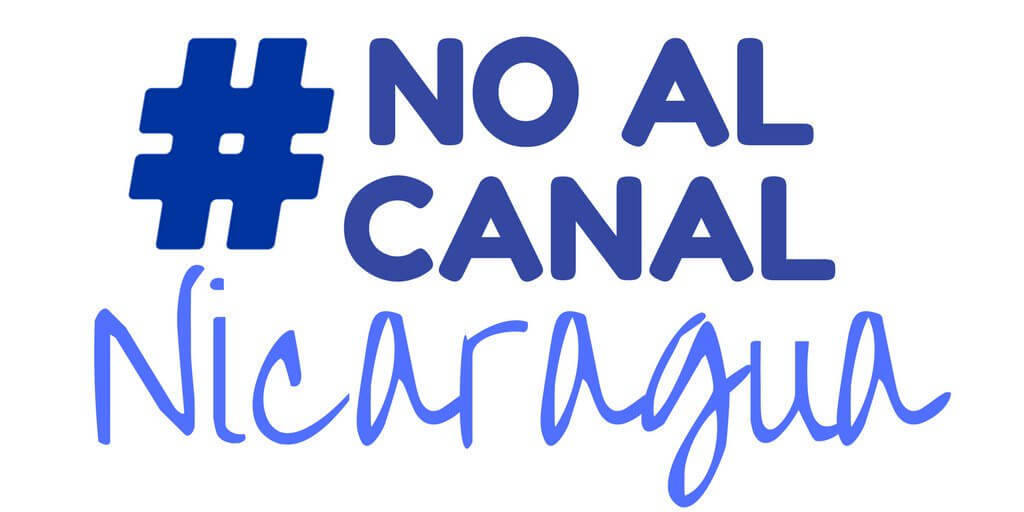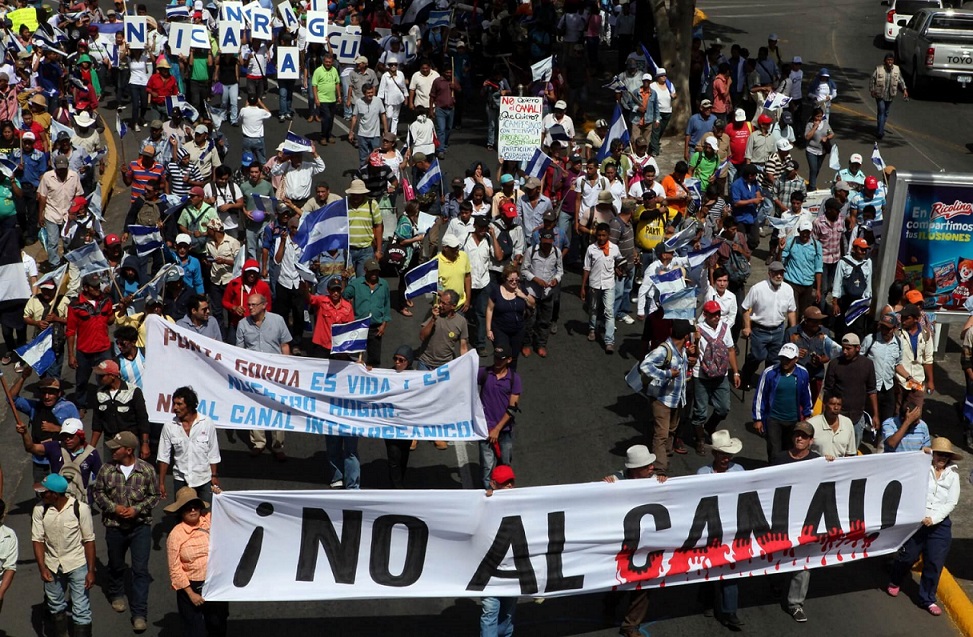
by Deep Green Resistance News Service | Mar 20, 2018 | Lobbying
Featured image: Mario Lopez/EPA
by Gabriella Rutherford / Intercontinental Cry
Indigenous communities know all too well of the potentially devastating risks that the construction of mega-projects can entail. Time and again, such projects have led to irreparable environmental damage that harmed if not destroyed the well-being, culture, economy and traditional ways of local communities.
The Raizal Peoples who inhabit the San Andrés, Providencia and Santa Catalina archipelago, Colombia could become one more indigenous community to be affected in this way. Should Nicaragua’s plans to build a canal go ahead, there is the risk that the massive project—that would rival the Panama Canal—would muddy and pollute nearby waters and potentially destroy the reef on which the Raizals depend.
With the risk of environmental damage and potentially devastating consequences for the Raizal Peoples in mind, Colombia applied to the Inter-American Court for information as to how it might interpret human rights law in this case. In response, the Court issued an advisory opinion in which it elaborated at length on the relationship between the environment and human rights law.
The Court noted, “Environmental damage can cause irreparable damage to human beings. As such, a healthy environment is a fundamental right for the existence of humanity.”
Its findings, though non-binding, sent out a strong message to both the regional and international arena that not only is there an inextricable link between a healthy environment and human rights but that this should be accounted for in the interpretation of human rights instruments.
In practice, this means that someone could in theory now bring a case before the Court on the grounds that environmental damage had led to a violation of their human rights. While significant legal obstacles have previously made it difficult for affected parties to seek meaningful redress in such cases, the verdict could not be more timely.
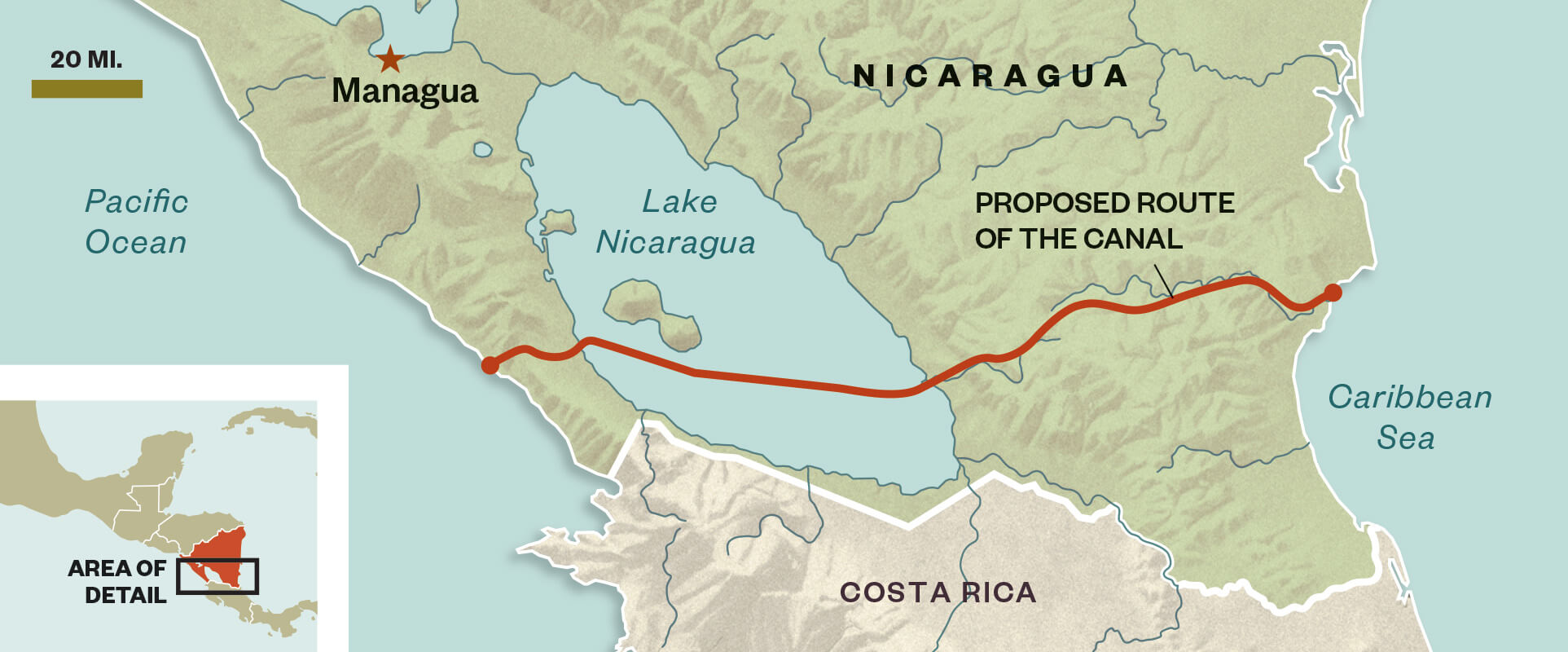
Proposed route of The Nicaraguan Canal (Spanish: Canal de Nicaragua), formally the Nicaraguan Canal and Development Project (also referred to as the Nicaragua Grand Canal, or the Grand Interoceanic Canal)
To date, claimants in the Americas affected by environmental damage have struggled to pursue legal action for the violation of their human rights for the following reasons:
Right to a healthy environment (San Salvador Protocol, article 11) not accepted as basis for a claim
Firstly, despite the fact that Article 11 of The San Salvador Protocol explicitly sets out the right to a healthy environment, this right is non-justiciable. That is to say, no-one could use a violation of this right as a basis for which to file a petition to the Inter-American Commission of Human Rights, and subsequently the Inter-American Court. Instead, the affected individual or group would have to bring a case under Article 26 of the American Convention on Human rights, the rights of which are justiciable.
The problem is that, while Article 26 protects economic, cultural and social rights, the only obligation it imposes on States is that they progressively achieve the full realization of these rights, making it an aspirational ideal for member States. For this reason, neither the Commission or the Court had previously ever found in favour of a claimant who had asserted their rights under this article. Furthermore, is has been unclear whether the right to a healthy environment would be deemed as being included in the scope of the rights protected under Article 26.
Problems of transboundary cases
In some cases, the cause of environmental damage occasioned in a particular place lies outside of a country’s border. This is problematic because human rights instruments are traditionally understood to only hold states responsible for damage occasioned in that same state, not for damage outside of their borders. This rather nebulous realm of extraterritorial obligations is, as one legal expert noted, “the conundrum…that bedevils human rights law”. If we can find some clarity in this rather nebulous world of international law it is that no-one hoping to a pursue legal action through the regional courts in the case of a transboundary claim could be confident their claim would be admitted.
Problems of bringing claims on the basis of violation of right to life
In theory, another means through which a potential affected party could file their complaint with the Inter-American Commission would be through arguing that their right to life had been violated as a result of environmental degradation. However, case law from the Inter-American Court shows that should a complainant want to argue their case on this basis, they would have to prove that the state had taken action which could be deemed to have an “immediate” and “certain” consequence on their exercise of their right to life–and that action wasn’t taken to “reasonably” prevent the risk of this happening.
There are cases which fall into this category such as Sarayaku vs. Ecuador, where explosives were laid on the Sarayaku territory or, for example, in Yanomami vs. Brasil where a highway was built though Yanomami land which resulted in several deaths. This said, clearly trying to prove the immediacy and certainty of a risk to life and integrity limits the number of cases significantly. By means of example, in 2005 when the Inuit argued that their traditional means of subsistence had been destroyed by climate change, the Inter-American Court did not find in their favour. Though the Court was not explicit with regards to its reasons for not accepting this argument, it can be supposed that it was indeed difficult to prove that climate change would have resulted in an “immediate” and “certain” negative impact on the subsistence of the Inuit Peoples and consequently their right to life.
The advisory opinion issued on Feb. 7 addresses these problems in the following way:
The right to a healthy environment
Firstly, the court reaffirmed the landmark decision made in the recent Lagos del Campo vs. Peru case, in which they found for the first time in favour of a claimant who had raised a petition on the basis of his Article 26 rights being violated. Secondly, the Court recognized that the right to a healthy environment as set out in the San Salvador Protocol was an autonomous right and crucially, should be deemed as being included in the rights set out in Article 26. What this means then is that the door is laid open to future claims for loss of a healthy environment brought under Article 26 of the American Convention, something that was not previously possible.
Transboundary claims will be actionable in the case of environmental damage
The Court found that countries will be held accountable for the violation of rights when the activities causing those violations are in their “effective control” i.e. they are responsible for them. This marks a significant widening of the traditional scope of a state’s responsibilities.
On this basis then, if, for example a state did complete a mega-project, the effects of which were felt outside of their borders, a case could be brought against them. In Colombia’s case, the Court seems to indeed be suggesting that should Nicaragua’s canal result in environmental damage in Colombia, affected parties would indeed have a case.
Some experts have noted that this could have important repercussions for air pollution, chemical pollution and even climate change.
Risk to life must still be “immediate” and “certain” but in the case of the possibility of significant environmental damage, a state has an obligation to prevent it taking place.
As expected, the Court’s opinion signaled no change with regards to the need for claimants to prove that actions undertaken would “immediately” and “certainly” result in the violation of their right to life. As such, it will remain difficult to bring forward claims on this basis. However, the Court did importantly recognize the very real potential that environmental damage has to cause violations of the right to life or right to integrity. With this in mind, it made several stipulations:
Firstly, the Court stated that States must prevent “significant environmental damage” (understood as damage that will violate right to life or integrity) both in or outside their borders. Secondly, it stipulated that they must do so even if there is no scientific certainty of such environmental damage: it is sufficient that significant environmental damage was possible.
The Court also offered clarity about what was understood by the meaning of the word ‘prevention’. It found that a State must conduct thorough and independent environmental impact studies as well as providing mitigation and contingency plans in the case of damage; regulate, supervise and monitor activities that could cause harm; cooperate with other States, providing them with information regards risks to the environment and ensure that potentially affected parties have access regarding potential harms
There is no doubt that the Inter-American Court’s findings offer reasons for optimism for both environmental and indigenous rights activists alike. Though non-binding, the advisory opinion provides a sign post for Courts of member States as well as lending much-needed legal weight to arguments made by potential claimants. Indeed, the advocacy group Dejusticia—which is currently pursuing legal action against the Colombian State for failing to curb deforestation in the Amazon—has said that it will use the findings to bolster its arguments. Of course, the advisory opinion will likely carry weight further afield too. The fact that a major human rights body such as the Inter-American Court has taken active steps to better protect citizens from the very real effects of environmental damage will surely put pressure on other major bodies to do the same.
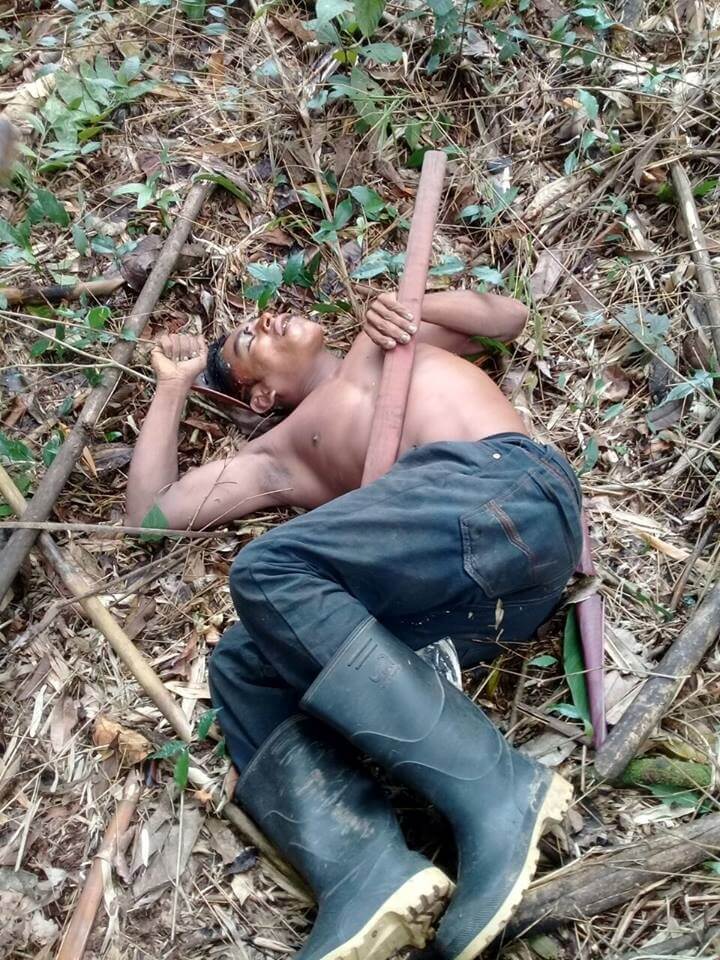
by Deep Green Resistance News Service | Dec 7, 2017 | Colonialism & Conquest
Featured image: Cejudhcan Derechos Humanos
by Courtney Parker / Intercontinental Cry
¡Ya Basta! A phrase known for its political and revolutionary connotations throughout much of the Spanish-speaking world, translates roughly into English as, ‘Enough is Enough!’
It is a statement of finality; a concrete call to action; a heightened call for awareness; and an official call of duty to end cultures of violence and impunity against Indigenous Peoples.
His name was Felipe Perez Gamboa. He was 24 years old.
According to Mark Rivas, who has aided in representing the Moskito Council of Elders at the United Nations, Gamboa was a leader of much distinction among the young people of the community of La Esperanza on the traditional Indigenous frontier region of Moskitia – located on the northern Caribbean coast of colonial Nicaragua and home to the largest tropical rainforest, second only to the Amazon, in the western world.
For his part, Rivas credited Cejudhcan Derechos Humanos – a local NGO whose founder, lawyer Lottie Cunningham, and staff, have been on the receiving end of death threats for their ongoing human rights work in the region – with originally disseminating and confirming the tragedy to the larger community.
The traditional Indigenous frontier regions of Moskitia have been terrorized by mounting acts of deadly colonial violence, stemming from the expanding agricultural frontier and the rigidly nationalist agenda, since 2015.
IC first began reporting on the escalating tragedies in the traditional Indigenous regions in June of 2016.
Readers may refer to previous analyses here and in other outlets concerning the role of the Ortega government, neoliberalism, and the fraudulent banner of ‘Christian Socialism’ the fallen Sandinista leader still attempts to hang over his tenuous authoritarian rule.
As of right now, we can do no more than reach out to the Indigenous rights community in the rest of Latin America, and across the world, with the simple message, made famous by the Zapatsista, that ‘Enough IS Enough’.
It’s time to end this culture of impunity surrounding deadly violence against Indigenous Peoples – in this instance, those who are protecting the last bastions of a biodiverse, climate mitigating rainforest.
¡Ya basta!
¡YA BASTA!
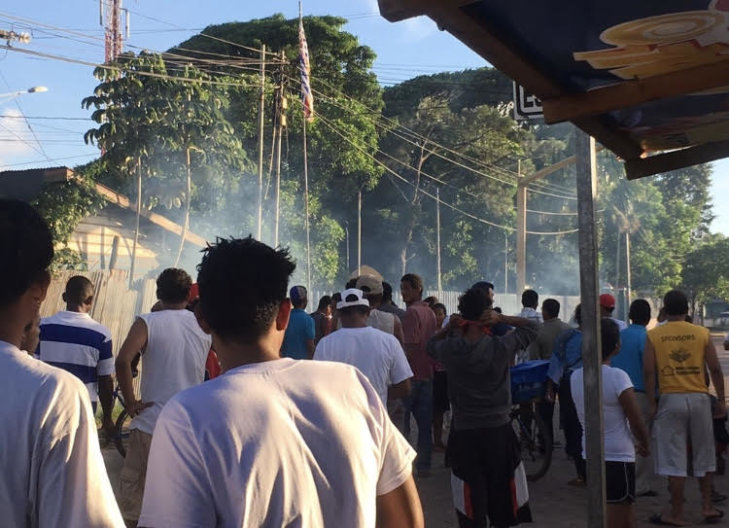
by Deep Green Resistance News Service | Nov 15, 2017 | Colonialism & Conquest
by Brett Spencer / Intercontinental Cry
On Saturday, Nov. 11, members and supporters of the Miskitu indigenous party, Yapti Tasba Masraka Nanih Aslatakanka (YATAMA) crowded into their burnt down compound to celebrate their thirtieth anniversary. Over one thousand people were present, including many from surrounding villages that came to listen to the party’s political leader and congressman, Brooklyn Rivera.
The celebration came just days after riot police and military were flown in from Managua to control dissent following Nicaragua’s municipal elections. YATAMA and its supporters roundly denounced the election results on Nov. 5 that deposed them of control of the municipalities of Bilwi, Waspam, Prinzapolka and Awaltara.
YATAMA’s supporters, who took to the streets in protest of the results—which YATAMA deemed fraudulent—were met with violence by military and paramilitary forces carrying automatic weapons.
“We were protesting electoral fraud,” said the party’s leader, Brooklyn Rivera. “We were protecting our people. We were not expecting the military or the police to attack. Our youth tried to resist the attack, but you cannot fight back with rocks when they have machine guns.”
The violence in Bilwi reached a new low when YATAMA’s headquarters was set on fire Monday night. At least part of the event was caught on film, but no one has taken responsibility for setting fire to the compound.
YATAMA and many residents of Puerto Cabezas-Bilwi say that local residents are not responsible.
Brooklyn Rivera, who was in his office when the building was set ablaze, insists that it was the police and army. “I was inside there when they attacked. It was not the Sandinista youth or local Sandinista members. It was the army and the police who did this, not our local people. This violence was organized from Managua,” he said.
IC confirms that party leadership has been harassed, attacked and threatened by military and paramilitary personal as government forces laid siege to the city. “The burning of the YATAMA house, the radio station and the destruction of the Indian statue came directly from the special forces of the police, not from some local Sandinista group,” said Mr. Rivera. “The leadership of YATAMA is not fighting, we are here accompanying our people.”
These allegations suggest that the post-election unrest in Bilwi is not a local conflict of “Miskitu versus Miskitu,” but rather a government crackdown on indigenous resistance. There are currently one hundred and three political prisoners in Bilwi following the municipal elections, and the arrests of protesters throughout the country show that distrust of the democratic process in Nicaragua is not isolated to the Atlantic Coast.
Mr. Rivera was pleased to have peace during the party’s celebration, and he is already planning a path forward to remain a pillar of support for the indigenous population. “We must rebuild, it is important that our people have staples of communication and resistance like our radio station to keep unity in our communities.”
It has been a difficult week for the party, as it comes to terms with the iron grip of militarization. The aftermath of the election has left many questioning if YATAMA should direct itself away from a political agenda, when each election is met with allegations of fraud and violence.
Mr. Rivera understands this sentiment and frustration, citing a recent resolution by the Inter-American Court of Human Rights, he commented, “We are violating our own rights by participating in this election.”
When asked why the national government has exhausted so much power to prevent YATAMA from succeeding, Mr. Rivera did not hesitate. “They are trying to colonize our people and our land to control our natural resources. We resisted, and now they are trying to totally destroy indigenous organization.”
As relations between YATAMA and the Ortega administration continue to deteriorate, residents are beginning to accuse the government of resorting to the same kind of reactionary violence seen in the 1980s. For now, the city remains peopled with military personnel, as YATAMA plans to reopen its radio station and reconstruct its pillars of resistance.
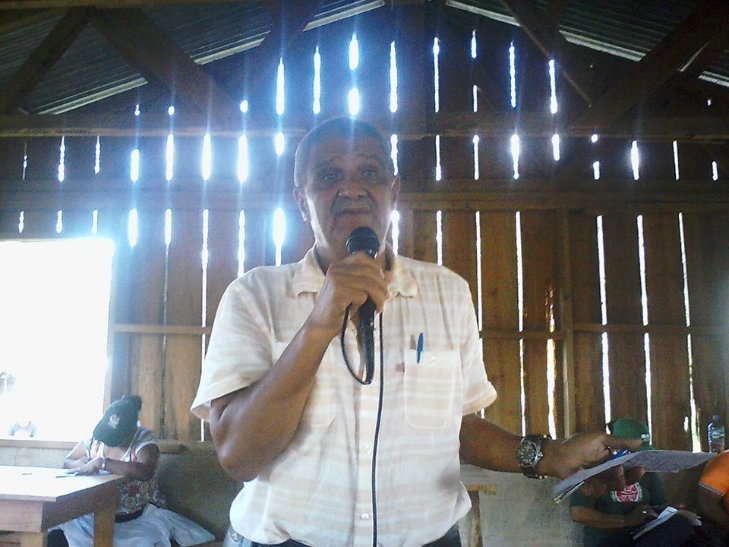
by Deep Green Resistance News Service | Nov 11, 2017 | Colonialism & Conquest
Featured image: Amid reports the Sandinista army has ordered his capture or execution; historic political and spiritual leader of the Indigenous political party of Yatama, Brooklyn Rivera, prepares to brave a public appearance. Photo: Lloyd Lopez
by Laura Hobson Herlihy / Intercontinental Cry
Since the elections on Sunday Nov. 5, Yatama has lost far more than the municipalities of Waspam, Bilwi, Prinzapolka, and Awaltara. At least four people have been killed, dozens have been injured, and 50 have been taken as political prisoners; Yatama’s Miskitu-language radio station and sacred headquarters was burned down; the “indio guerillero” (warrior Indian) statue was destroyed; and Yatama’s own flag was replaced by the flag of the Sandinista nation-state. Their backs are to the wall.
Yatama leaders’ feelings of helplessness does not fit within the Miskitu world-view, however. The Miskitu Peoples still see themselves as successful warriors. They fought alongside the British during the colonial era and were not conquered by the Spanish until 1894, when their Muskitia homeland was incorporated into the Nicaraguan state. As fighters in the US-backed Contra War within the Nicaraguan revolution (1979-1990), the Miskitu were awarded a pluri-ethnic homeland, almost half of the country, with two politically autonomous regions.
So why now in 2017 do the Miskitu feel helpless? In the past, the Miskitu aligned with the British and US governments. Today, they have no international alliances. Only Russia and China are current players in Nicaragua. Chinese mega-projects and Russian military bases and armory, including a recent purchase of 50 tanks, fortify the Ortega government.
On Tuesday, Nov. 7, the Miskitu Yatama sympathizers placed a road block in Sisin, blocking passage of vehicles and haulting commerce between Waspam and Bilwi. Rumors began that Yatama men were arming themselves in rural communities and planned to fight in Bilwi and burn down the entire town of Bilwi (pop. 50,000), the capital of the North Caribbean Autonomous Region. The US Embassy evacuated its Fulbright scholar in Tuapi. Bilwi residents experience anxiety and PTSD.
Speaking with Brooklyn Rivera by phone on the evening of Friday, Nov. 10, IC asked him directly if Yatama is planning to cause violence. He told us, “No, we are the victims of violence. The state is committing violence against us. We are poor indigenous people. We don’t have guns, we have rocks and they have automatic weapons. We can’t fight that.”
When asked if his troops are arming in communities, he responded, “That is just gossip.”
We also asked if Yatama plans to burn down Bilwi. He told us, “No, how can we burn down our home?”
Rivera continued, “Thousands of Miskitu people were not allowed to vote in the municipal elections. Then, the Riot Police from Managua backed by the local Bilwi Police burned down the Yatama radio station and headquarters.”
Rivera, now 65 years old, has served as the highest leader of the Miskitu people since the early 1980s. On the Monday following the 2017 municipal elections, Rivera had a busy day—he escaped from Riot Police and later, the devastating fire at the Yatama house.
Rivera interjected, “Tomorrow at 1:00 in the baseball stadium, we will celebrate Yatama’s 30-year anniversary.” He is the founder and long-term Yatama director. We asked if he plans to attend the celebration. Rivera replied quickly, “Sure, I have to celebrate along with my people.” We pointed out that he may be arrested. He demured, “I am ready for anything that comes. I am the leader of my people, I have done nothing wrong. I haven’t killed anyone.”
Meanwhile, Bilwi sleeps lightly tonight, with the Yatama celebration planned for mid-day. Bilwi is highly militarized, with over 100 riot police roaming the streets along with rogue neighborhood gangs. Any gathering could easily turn into a violent confrontation. The stage is set for a showdown.
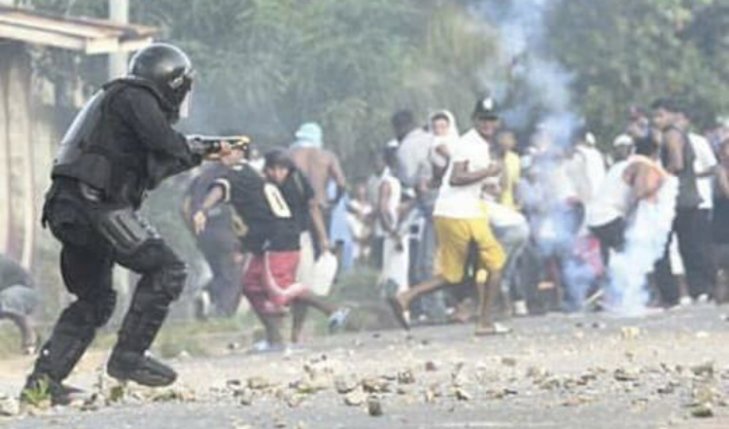
by Deep Green Resistance News Service | Nov 10, 2017 | Colonialism & Conquest
by Laura Herlihy / Intercontinental Cry
The Nicaraguan Sandinista (FSLN) government of Daniel Ortega and the indigenous Miskitu people are repeating their own history. Resembling the Cold War era of the 1980s, violence is playing out again along the Caribbean Coast. At least four indigenous Miskitu men are dead, several are missing, and many more have been taken as political prisoners and prisoners of conscience in the violent anti-indigenous riots that followed the municipal election in Bilwi-Puerto Cabezas on Sunday, Nov. 5.
A few hours after polls closed, officials from the indigenous political party Yatama (Yapti Tasba Masraka Nanih Aslatakanka/Children of the Mother Earth), calculated having nearly 3,000 more votes than the opposition FSLN party. While Yatama officials awaited the arrival of ballot boxes from their loyal communities, the FSLN claimed victory and celebrated shortly after 10:00 PM. The following day, Yatama officials denounced the FSLN for lack of transparency in the election; they also claimed to have documented electoral fraud and voter suppression, through the manipulation of voter data, multiple voting by FSLN sympathizers (by using removable ink on their thumbs); and the purchasing of votes.
Yatama held a protest march on Monday afternoon but were confronted by Riot Police brought in from Managua, backed by Sandinista youth gangs. The Riot Police reportedly turned a blind eye to the gang’s destruction of property belonging to Yatama sympathizers, including costly vehicles.

A car set on fire during the massive riot lights up the night
Later, both the Yatama headquarters (a sacred temple of indigenous identity) and Radio Yapti Tasba (Yatama’s indigenous language-based, community radio station) were destroyed by fire.

Rampant destruction across Biliw (also known as Puerto Cabezas) included the YATAMA Indigenous party headquarters and both of their radio stations, leaving the Sandinista radio station as the only operating, on-air station in a region which relies on community radio as a prime source of information
The FSLN flag was then mounted high upon the surviving radio tower, replacing Yatama’s flag.

Raising of the FSLN flag
Perhaps most symbolically, the iconic statue of the Indian (“El Indio”) was demolished in Bilwi’s town center. The statue, erected decades ago, represented the indigenous struggle. Caribbean coastal residents lost a significant amount of their cultural patrimony in one volatile day.

The iconic statue before it was destroyed

Local intellectuals claim this election and its aftermath symbolize the final conquest and domination of the Muskitia region, finishing off what Rigoberto Cabezas initiated in 1894, when he incorporated the Muskitia territory into Nicaragua and ousted the last Miskitu King, Robert Henry Clarence. Today, in a similar way, the Sandinista state attempts to eliminate the long-term spiritual and political leader of the Miskitu people, Brooklyn Rivera, and the Yatama organization he founded almost 30 years ago to the day, on Nov. 11, 1987.
Para-military forces apprehended Rivera the afternoon of Monday, Nov. 6, but he escaped when Yatama youth fought his captors. Rivera and other top Yatama leaders (Reynaldo Francis, Bilwi’s 2017 Yatama mayoral candidate, and Elizabeth Henriquez) are now in hiding, threatened by arrest warrants and the burning of their houses by FSLN sympathizers. Their children also remain in hiding, along with many Yatama officials and their family members.
Since 2008, a new wave of colonization has occurred in the Nicaraguan Muskitia by mestizo agricultural and cattle-ranching colonists from the Pacific. Colonists cut down trees in ancestral, indigenous rainforest lands, illegally settle in the region, and vote Sandinista.
To date, in their fight with the colonists, 44 Miskitu men have been killed, 22 have been kidnapped, and dozens have been injured. These indigenous environmental activists are protecting their rainforest lands for the global good. The IACHR (Inter-American Commission on Human Rights) passed two resolutions in 2015 and 2016, urging the state to protect the Miskitu people, but the Nicaragua state has not complied.
Accused Sandinista aggressions since the Municipal Elections include:
- Arbitrary repression and imprisonment of indigenous people.
- Burning of indigenous community radio station Yapta Tasba of the Yatama organization.
- Burning of the Yatama headquarters that served as a scared temple for its indigenous supporters.
- Criminalization of Yatama leaders, including the detainment of long-term leader and national congressman Brooklyn Rivera, who escaped from para-military police.
- Destruction of monuments: the Indian statue in the town’s center that stood as a symbol of indigenous resistance for 30 years.
- Suppression of the Yatama flag by the FSLN flag.
- Militarization of communities with Riot Police, who voted in local elections although not residents.
- At present, the Riot Police from Managua are fighting with automatic weapons against indigenous Yatama youth armed with mainly mortar, rocks, handguns, and knives.



